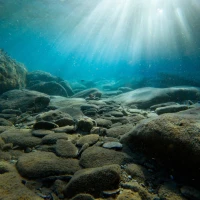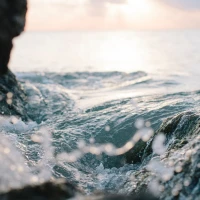Underwater photography is a captivating and challenging form of photography that allows us to explore the enchanting world beneath the ocean’s surface. It offers a unique opportunity to capture the beauty and mystery of marine wildlife with precision. Whether you are an experienced diver or a beginner, mastering the art of underwater photography requires a combination of technical knowledge, creativity, and a deep understanding of the marine environment. In this article, we will delve into the world of underwater photography, exploring the equipment, techniques, and tips that will help you capture stunning images of marine wildlife.
The Fascination of Diving
Diving is not just a sport, but a way to immerse oneself in a completely different world. As you descend into the depths of the ocean, you enter a realm teeming with life, vibrant colors, and breathtaking beauty. The tranquility and sense of weightlessness underwater offer a sense of freedom and serenity that is unparalleled. This unique experience has captivated divers and photographers alike, inspiring them to explore the wonders of marine life through their lenses. Underwater photography allows us to capture the essence of this underwater world and share it with others.
The Importance of Underwater Photography
Underwater photography serves several important purposes. Firstly, it allows us to document and study marine wildlife. Many species of marine life are elusive or difficult to observe in their natural habitats. Through underwater photography, we can document their behavior, habits, and interactions, providing valuable information for researchers and conservationists. Additionally, underwater photography plays a crucial role in raising awareness about the fragility and beauty of marine ecosystems. By capturing stunning images of marine life, we can inspire others to appreciate and protect these vulnerable habitats. Lastly, underwater photography is a means of personal expression and creativity, allowing photographers to share their unique perspectives and experiences of the underwater world.
Essential Equipment for Underwater Photography
Ultimate Guide to Free Diving for Beginners capture marine wildlife with precision, you need to invest in reliable and high-quality photography equipment. Underwater photography requires specialized gear that can withstand the harsh conditions of the underwater environment. Here are some essential equipment items you will need to get started:
1. Underwater Camera Housing
An underwater camera housing is a protective case that encloses your camera and lenses, keeping Discover the Beauty of Deep Sea Divingm safe from water damage. It should be specifically designed for your camera model to ensure a snug fit and proper functioning. The housing should have controls that allow you to adjust camera settings underwater, such as aperture, shutter speed, and ISO. Choose a housing made from durable materials like polycarbonate or aluminum to withstand pressure and potential impacts.
2. Camera and Lenses
When it comes to choosing a camera for underwater photography, Mastering the Art of Free Diving Techniquesre are two main options: compact cameras and DSLRs or mirrorless cameras. Compact cameras are smaller, more portable, and often come with preset shooting modes optimized for underwater conditions. DSLRs or mirrorless cameras, on the other hand, offer greater flexibility and image quality with interchangeable lenses.
For lenses, wide-angle lenses are ideal for capturing expansive underwater scenes, such as coral reefs or large marine species. Macro lenses, on the other hand, are designed for close-up shots of small subjects like marine invertebrates or intricate coral formations. Consider investing in both types of lenses to cover a wider range of photographic opportunities.
3. Strobes or Underwater Flash
Natural light diminishes rapidly as you descend underwater, resulting in dull and colorless photographs. To counteract this, you will need artificial lighting in the form of strobes or underwater flashes. They provide a burst of light to illuminate the subject, enhance colors, and add depth to your images. Position your strobes strategically to avoid backscatter, which occurs when light reflects off particles in the water, causing unwanted specks in your photos.
4. Buoyancy Control Device (BCD)
A BCD is an essential piece of cave diving equipment equipment that allows you to control your buoyancy underwater. It is also useful for carrying your camera and other gear comfortably. Look for a BCD that has integrated weight pockets and D-rings to attach accessories like strobes or underwater lights. Proper weight distribution and balance are crucial for maintaining stability while capturing images underwater.
5. Diving Torch
A advanced cave diving techniques torch is useful for exploring the underwater environment and illuminating dark areas when photographing marine wildlife. It can help you spot hidden subjects, reveal vibrant colors, and add depth to your images. Choose a torch with adjustable brightness settings and a wide beam angle for maximum versatility.
6. Lens Filters
Lens filters are essential for achieving accurate color rendition and correcting color cast caused by water absorption. They help restore the natural colors underwater, making your images vivid and true-to-life. Popular filters used in underwater photography include red filters for tropical waters and green filters for temperate or cold waters. Consider investing in a filter system that is compatible with your camera and lenses.
Techniques for Underwater Photography
Now that you have the necessary equipment, it’s time to master the techniques that will enable you to capture stunning images of marine wildlife underwater. Here are some essential techniques to consider:
1. Master Buoyancy Control
Buoyancy control is crucial for capturing sharp and well-composed images underwater. As a diver, it is essential to achieve neutral buoyancy, where you neither sink nor float but remain suspended in the water column. This allows you to maintain stability and easily maneuver around your subjects without disturbing them or damaging the delicate marine ecosystem. Practice your buoyancy control skills before attempting underwater photography to ensure a smoother and more enjoyable experience.
2. Get Close and Low
Underwater photography often requires getting close to the subject to capture details and create impactful images. The water acts as a natural magnifier, making objects appear 25% larger and closer than they actually are. To capture the essence of marine wildlife, make an effort to get as close as possible while maintaining a safe distance to avoid causing stress or harm to the animals. Additionally, shooting from a lower or eye-level perspective can create a more intimate and engaging connection between the viewer and the subject.
3. Utilize Natural Light
While artificial lighting is essential in underwater photography, it is equally important to utilize natural light whenever possible. Natural light can add a beautiful and ethereal quality to your images, creating stunning effects and highlighting the natural environment. Experiment with different times of the day to take advantage of favorable lighting conditions, such as sunrise or sunset when the light is softer and warmer.
4. Understand Color and Composition
Color and composition play a significant role in underwater photography. Understanding color theory and how light behaves underwater will help you capture vibrant and visually appealing images. As you descend underwater, colors are absorbed at different wavelengths, resulting in a shift in color appearance. Reds and oranges are the first to disappear, followed by yellows and greens, while blues and purples remain more visible. Utilize color filters, adjust white balance settings, or experiment with post-processing techniques to correct and enhance colors in your images.
Composition is another crucial aspect of underwater photography. Use the rule of thirds, leading lines, and framing techniques to create visually engaging and balanced compositions. Pay attention to the background and foreground elements to ensure they complement the subject and add depth to your images.
Tips for Successful Underwater Photography
To further improve your underwater photography skills, consider the following tips:
-
Research the Dive Location: Before embarking on an underwater photography expedition, research the dive location thoroughly. Learn about the marine life, currents, visibility, and dive conditions to prepare yourself and plan your shots accordingly.
-
Patience is Key: Underwater photography often requires patience and persistence. Marine wildlife can be unpredictable, and capturing the perfect shot may take time. Be prepared to spend hours observing and waiting for the right moment to capture a captivating image.
-
Shoot in RAW: Shooting in RAW format allows for greater flexibility in post-processing. RAW files preserve more information and allow you to adjust exposure, white balance, and other settings without compromising image quality.
-
Practice Regularly: Like any skill, underwater photography requires practice to improve. Take every opportunity to dive and hone your photography skills underwater. Experiment with different settings, techniques, and compositions to expand your creative possibilities.
-
Respect the Marine Environment: As underwater photographers, it is our responsibility to treat the marine environment with respect and minimize our impact. Avoid touching or damaging corals and marine life, maintain distance from sensitive areas, and adhere to ethical guidelines for interacting with wildlife.
Comparison Table: Compact Cameras vs. DSLRs/Mirrorless Cameras
When choosing a camera for underwater photography, you have the option of using a compact camera or a DSLR/mirrorless camera. Here is a comparison table highlighting the key differences between the two:
| Criteria | Compact Cameras | DSLRs/Mirrorless Cameras |
|---|---|---|
| Size and Portability | Small and lightweight, easy to travel with | Larger and bulkier, requires separate housing |
| Image Quality | Good for beginners, limited dynamic range and low-light capabilities | Excellent image quality, higher dynamic range and low-light capabilities |
| Lens Options | Fixed lens with limited zoom range | Interchangeable lenses, wide range of options for different shooting scenarios |
| Manual Controls | Limited manual controls, automatic shooting modes | Full manual control over settings, customized shooting modes |
| Price | Generally more affordable | Higher cost due to separate housing and lenses |
Conclusion
Underwater photography is a captivating and rewarding pursuit that allows us to capture the beauty and intricacies of marine wildlife with precision. By following the techniques, tips, and investing in the right equipment, you can create stunning images that showcase the wonders of the underwater world. Remember to respect the marine environment, practice regularly, and continuously improve your skills to become a proficient underwater photographer. So grab your gear, dive in, and embark on a journey to capture marine wildlife with precision and creativity. Happy underwater shooting!










